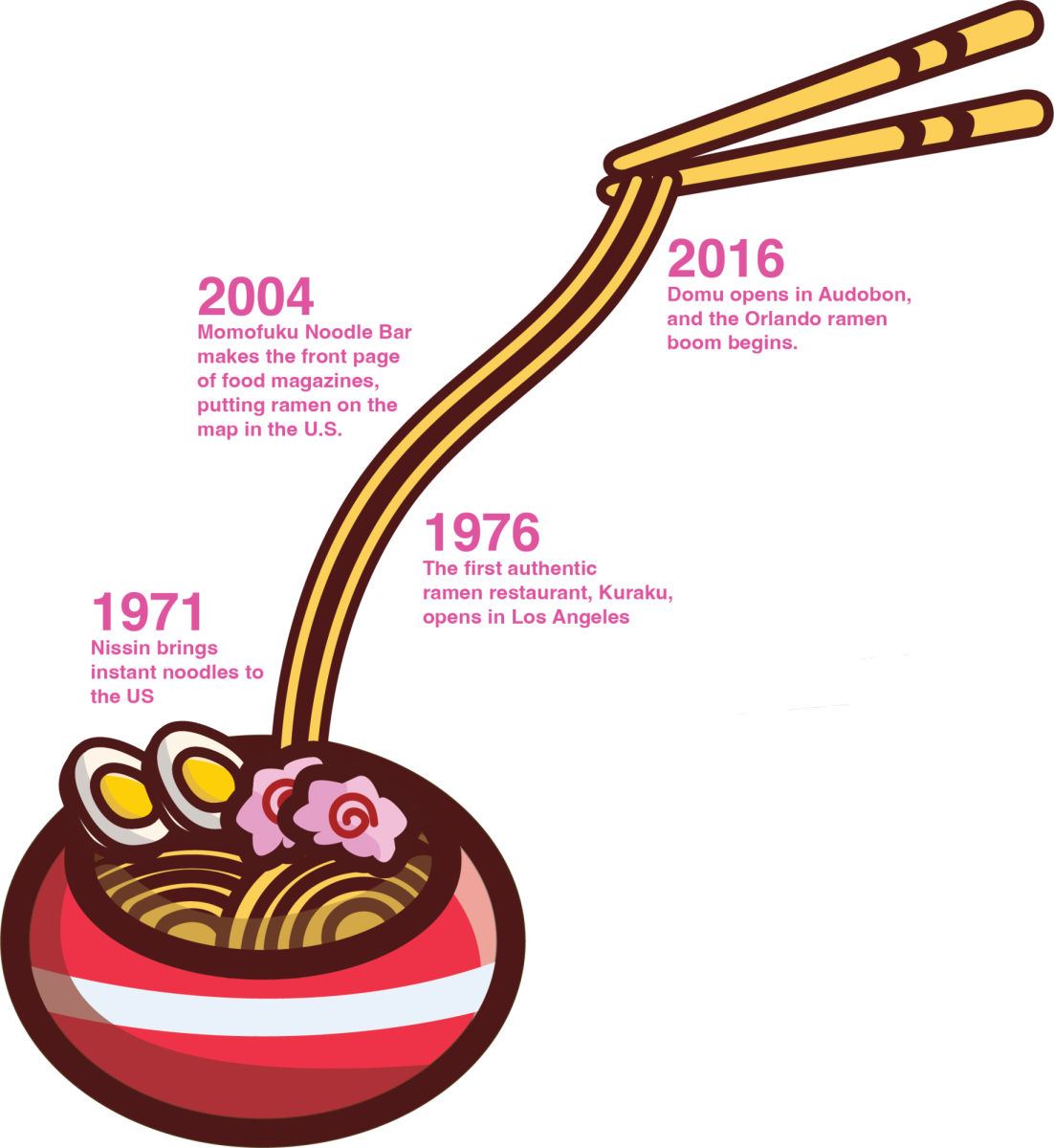Sitting in an Orlando ramen restaurant, sophomore Owen Raffa savors his steaming bowl of ramen noodles. The concept is simple, but the noodles, toppings and broth somehow combine to create a perfect harmony of umami (the Japanese word for “savoriness”).
Twenty years ago, these bowls of ramen were only common in Japan, but today, ramen restaurants are popping up all around the United States. Ramen is on the rise in America as a new comfort food, especially among the younger generation.
Rooted in simple goodness, ramen has always been a popular comfort food in Japan, with ramen restaurants found on every corner in big cities like Tokyo. Freshman Ryo Kimura has been to many ramen restaurants in both America and Japan, and he noted how common the restaurants were in the latter.
“There are a lot [of ramen restaurants],” Kimura said. “There’s got to be at least five in every department mall. You’ll find them everywhere from department malls to train stations.”
Ramen was originally seen as a cheap fast-food option in America because of the earlier introduction of instant ramen. However, traditional ramen rose in popularity in America when David Chang’s Momofuku Noodle Bar in New York City introduced authentic ramen and gave ramen a new image. As word of ramen spread, more restaurants opened and more people were able to experience the ramen trend. According to market research company Ibis World, the number of ramen restaurants in the U.S. has grown by an average of 3.9% each year from 2017 to 2022. Sophomore Victor Fang first discovered ramen through instant noodles and then experienced the joys of authentic ramen.
“My first experience of it was instant ramen when I was younger, like Shin Ramyun,” Fang said. “But my first real bowl of ramen I had was at Ichi-Ran in New York, where I had the pork (tonkotsu) broth.”
Part of ramen’s universal appeal is its ability to be customized. One component that can be customized is the broth, which goes beyond the standard shoyu (soy sauce) broth. The other popular varieties are shio (salt), miso and tonkotsu (pork bone) broths. Kimura prefers the miso broth but enjoys the wide assortment of options.
“For me, it’s definitely the broth that is my favorite part,” Kimura said. “You can choose from anything from the chicken broth, soy sauce taste and there’s some that have a miso taste. It’s important because some people like to enjoy it differently, and each person has their own opinion on foods. Sometimes they don’t want it to be spicy and want something sweeter, so they would order the soy sauce one.”
Toppings are another customizable feature of ramen, which helps draw in many ramen lovers. The toppings that go with ramen also come in many varieties, such as bamboo shoots, pork belly, bok choy, seaweed and bean sprouts, and add extra flavor and visual appeal.
“[Toppings] make it more than just brown and yellow for the noodles and the broth,” Kimura said. “It definitely adds a lot more color and flavor to the noodles, and as a result, you enjoy it more.”
Ramen’s influence has already extended to Orlando, and the number of ramen restaurants only continues to grow. A second Jinya Ramen Bar in Oviedo and Wa Ramen in Lake Nona are two new ramen restaurants that recently opened in October and November, respectively. The first Jinya location in Orlando was so successful that they decided to open a second one.
“Jinya’s original Florida location, in the heart of Thornton Park near downtown Orlando, is still humming along,” Mathew Moyer from the Orlando Weekly said. “In fact, it placed in our Best of Orlando’s readers poll last year for “Best Ramen” right behind local fave Domu, no shame.”
Some Orlando ramen places incorporate trends like anime into their restaurant theme, drawing in the younger generation. Soupa Saiyan and Dragon Bowl Ramen in Winter Park both feature wallpaper, figurines and posters that include characters like Goku from the Dragon Ball anime series. One of sophomore Owen Raffa’s first ramen experiences was when his brothers took him to Naroodle, which derives half of its name and includes art from the Naruto series.
“I think [ramen is popular] partially because of how popular animes have become,” Raffa said. “Especially in Naruto, the main character eats ramen in almost every episode and talks about how good it is, and a bunch of kids have been watching shows like that.”
Ramen is on the rise in America, and it will only continue to grow upward as more and more people find the joys of slurping up the umami goodness in every bowl of ramen. To put its newfound popularity into perspective, according to online media company Insider, an average of 4 billion servings of ramen are eaten in the U.S. annually.
“I like how ramen is made from a mixture of different things,” Raffa said. “The way the meat, vegetables, egg and noodles are all placed in the broth make it look just as good as it tastes.”
















